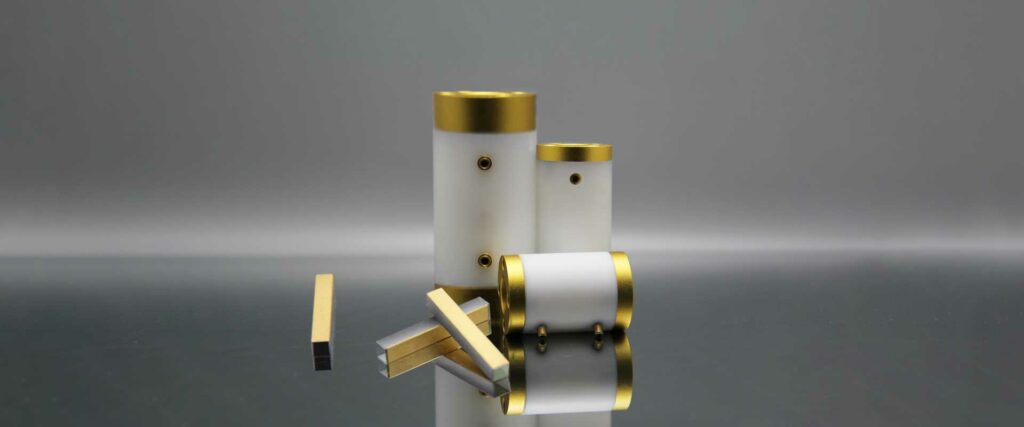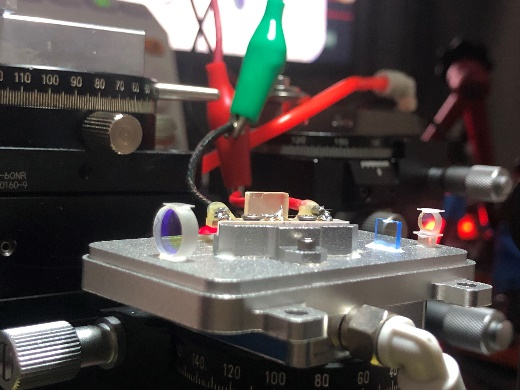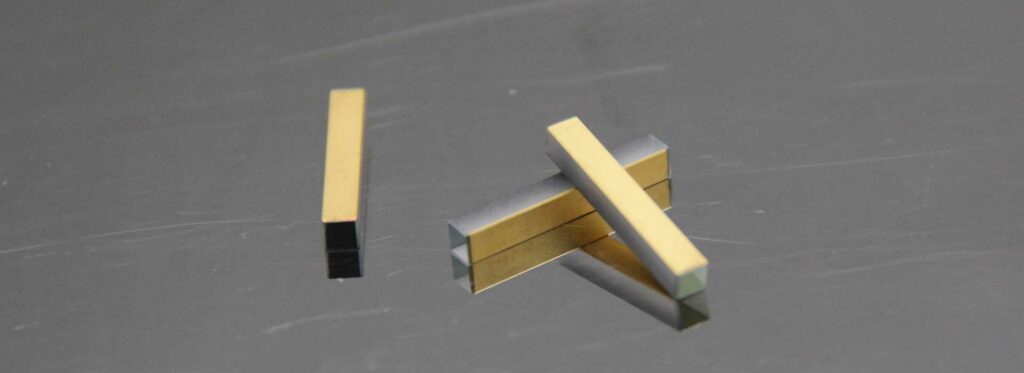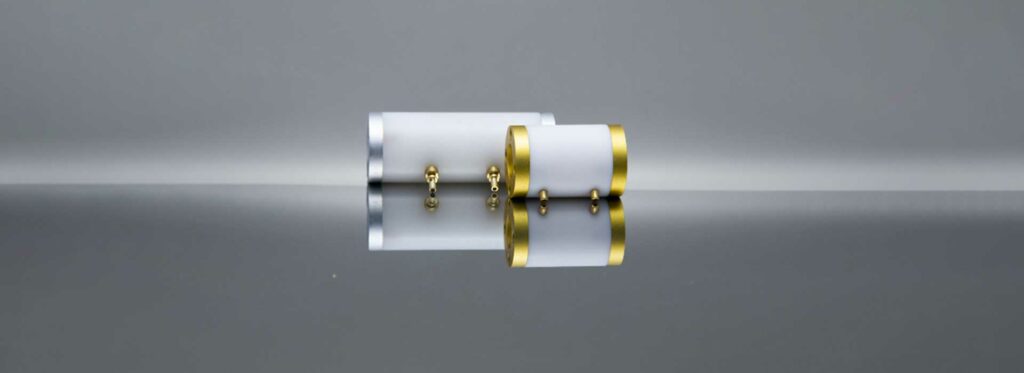The features and applications of BBO Pockels cells are introduced
BBO Pockels cell is an electro-optic modulator based on BBO (beta-BaB2O4) crystal. BBO Pockels cell, as a kind of high-speed, high efficiency, and high stability electro-optic modulator, has a wide application prospect in laser and optical communication systems.
The damage threshold refers to the maximum light intensity the battery can withstand in the electro-optic modulation process, beyond which the BBO crystal will be damaged or burned. The damage threshold is an important performance index of the electro-optic modulator, which can directly affect the reliability and stability of the laser system.

Advantage
High damage threshold
BBO Pockels cells have a high damage threshold compared to other materials. For example, a normal LiNbO3 Pockels cell typically has a damage threshold of around 1-2GW/cm2, while a BBO Pockels cell can have a damage threshold of more than 10GW/cm2. In addition, BBO Pockels cells have lower optical losses than other materials.
The BBO Pockels cell’s high damage threshold means it can be safely used in high-power, high-energy-density laser systems without being destroyed by light intensity. Therefore, it can improve the reliability and stability of the laser system. The high damage threshold also means BBO Pockels cells can achieve efficient light modulation without being limited by light intensity, thus enabling higher laser power and modulation depth.
To further increase the damage threshold of BBO Pockels cell, various measures can be taken, such as:
The growth process of BBO crystal was optimized to improve the crystal quality and uniformity.
The damage threshold of BBO crystal is maximized by appropriate polarization direction and optical wavelength.
The electrode and electrode structure was optimized to minimize the local light intensity and reduce the occurrence of damage.
In conclusion, BBO Pockels cells have a high damage threshold, which makes them excellent in high-power laser systems and can improve the reliability and stability of laser systems.

Low insertion loss
Insertion loss of BBO Pockels cell refers to the energy loss caused by the transmission of light by the electro-optic modulator component during electro-optic modulation. Insertion loss is another important performance index of the electro-optic modulator, which can directly affect the efficiency and energy consumption of the laser system.
BBO Pockels cells have low insertion losses compared to other materials. For example, while regular LiNbO3 Pockels cells typically have insertion losses of around 2-3 dB, BBO Pockels cells can reduce insertion losses to less than 1 dB. The low insertion loss of BBO Pockels cells is mainly due to its high electro-optic conversion efficiency, low optical loss, and optimized electrode structure.
The low insertion loss of the BBO Pockels cells means that it can achieve a higher depth of light modulation, resulting in increased efficiency and energy consumption of the laser system. BBO Pockels cells with low insertion loss can reduce optical signal attenuation and distortion compared to electro-optical modulators with high insertion loss, thus improving laser system signal quality and transmission distance. In addition, low insertion losses can also reduce the energy and heat consumption of laser systems, thus reducing system maintenance costs and environmental stress.
In conclusion, BBO Pockels cells are characterized by low insertion loss, which makes them excellent in laser systems and can improve their efficiency and energy consumption.
Fast switching speed
The switching speed of the BBO Pockels cell refers to the time it takes to achieve optical modulation. Switching speed is another important performance index of the electro-optic modulator, which can directly affect the accuracy and stability of the laser system.
BBO Pockels cells have faster switching speeds than other materials. While regular LiNbO3 Pockels cells typically switch at speeds ranging from tens of nanoseconds to microseconds, BBO Pockels cells can switch at nanosecond speeds. This is due to the higher nonlinear optical coefficient and shorter response time of BBO crystals. At the same time, BBO Pockels cells also enable faster reverse operation for faster light modulation.
The fast switching speed of the BBO Pockels cells means that it can achieve higher modulation frequencies and greater accuracy, resulting in improved performance and stability of the laser system. BBO Pockels cells with fast switching can achieve higher optical modulation depth and shorter response times than electro-optic modulator parts with slow switching, thus improving the signal quality and accuracy of laser systems. In addition, the fast switching speed can reduce the distortion and crosstalk of optical signals, thus improving the stability and reliability of the laser system.
BBO Pockels cells have fast switching speeds, a characteristic that makes them excellent in laser systems and can improve the accuracy and stability of laser systems.
Application case
BBO Pockels, as a high-performance electro-optic modulator, has a wide range of applications in laser systems. Here are some practical examples of BBO Pockels cells used in laser systems:
1. Q switch in high-power laser system: BBO Pockels cells are widely used in Q switches in high-power laser systems. The output of laser pulses can be achieved by rapidly modulating the BBO crystal to a high transmittance state. BBO Pockels cells’ high damage threshold, low insertion loss, and fast switching speed guarantee system stability and performance. For example, BBO Pockels cells have been successfully used in Nd: YAG and CO2 lasers in high-power laser systems.
2. Optical modulation in optical communication systems: BBO Pockels cells can be used for optical modulation and signal processing in optical communication systems. Due to the BBO Pockels cell’s fast switching speed and low insertion loss, higher modulation depth and higher modulation frequency can be achieved. In addition, the BBO Pockels cells’ high damage threshold also enables higher optical power and longer transmission distance. For example, BBO Pockels cells have been successfully used for light modulation in multi-photon microscopes.
3. Pulse extrusion technology: Pulse extrusion technology is a technology that uses an electro-optical modulator to compress ultra-short pulses. In pulse extrusion systems, BBO Pockels cells can achieve rapid modulation and compression of pulses. The BBO Pockels cells’ fast switching speed and great damage threshold ensure high accuracy and stability of the system. For example, BBO Pockels cells have been successfully applied to pulse extrusion technology in femtosecond laser systems.

Frank
Frank graduated from the University of Shanghai for Science and Technology, majoring in optics. As a technical engineer at Crylink Company, he deeply understands crystal materials and laser components.
Related Video(s) with this Article
Related Product(s) with this Article
Related Application(s) with this Article


